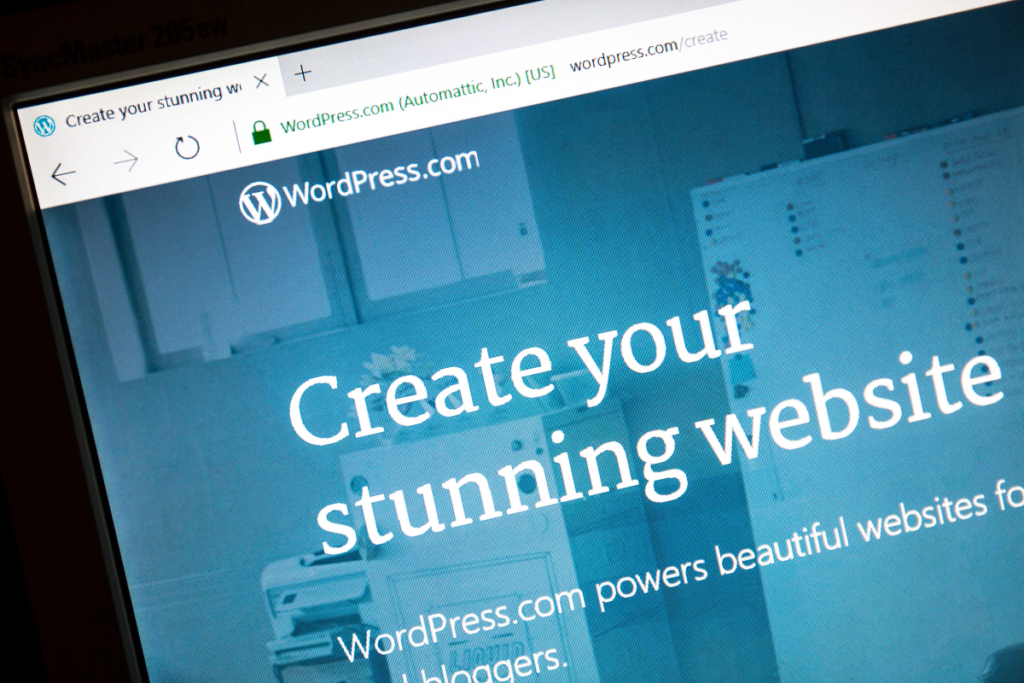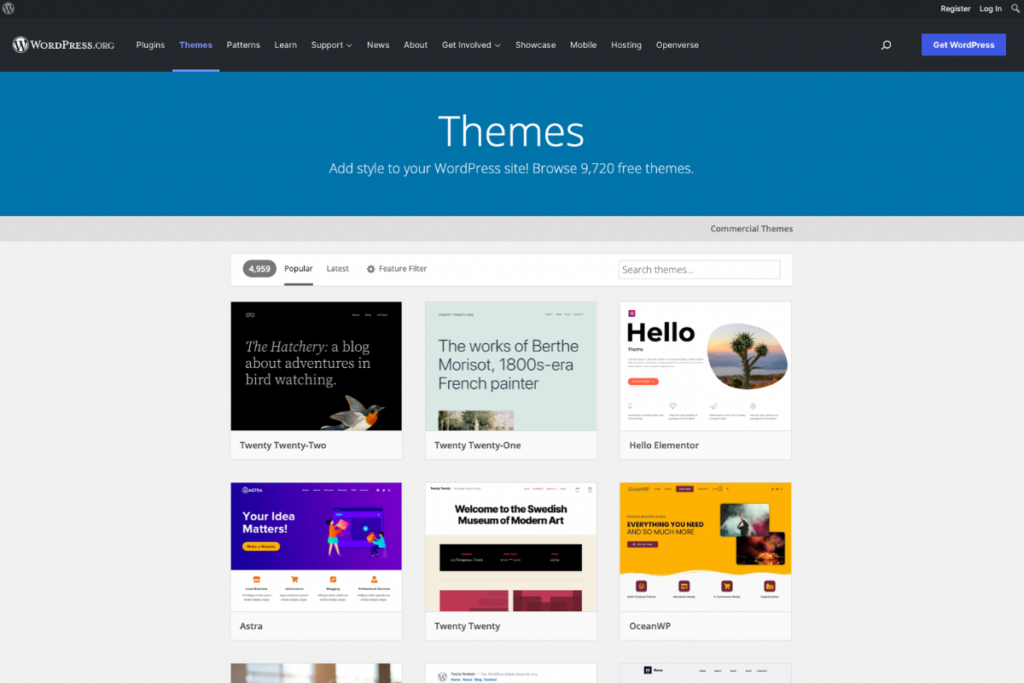With nearly 2 billion websites in the world, your website has to do a lot—has to be a lot—in order to capture the modern consumer’s attention. With its high-level functionality and autonomy, WordPress is easily one of the best website builders for local businesses trying to stand out.
But in a world of amazing sites, how do you build a WordPress website that really catches the eye—one that is functional, creatively impressive, and professional? After all, 75% of consumers judge a company’s credibility based on their website design.
Read on to learn how to set up and build the best WordPress website for your business.
Pros and cons of WordPress websites for small businesses
When it comes to flexibility and customization, WordPress is one of the best website builders out there for small businesses. There are basically no limits to how many features and functionalities you can add to a WordPress website. You can also use any number of third-party tools. And because you manage your own hosting, it is highly autonomous—more so than almost any other website builder.
However, this comes with its own complications. Because WordPress is a self-hosted platform, you definitely need some technical knowledge and skill to utilize it. Managing your own hosting can be complex, especially when it comes to security, so you may need to brush up on your coding. WordPress is also open-source, meaning no one owns it and there are no customer service resources to provide help. However, you can often solve problems by asking a developer or relying on community advice.

How to set up a WordPress website for a small business
Luckily, setting up a WordPress Website is straightforward and you need little technical knowledge to get started.
1. Choose a plan
First, select a WordPress plan on WordPress.com. WordPress does have a free option, but keep in mind that other packages give you a bit more to work with in terms of options. WordPress Starter, which is free for one year, includes payment collection, 6GB of storage, and Google Analytics integration. WordPress Pro ($15 a month) takes you up to 50GB of storage with unlimited plugins, premium support, premium themes, and the ability to sell products with WooCommerce.
2. Choose a domain name
Once you’ve chosen the right plan for your needs, it’s time to choose and set up your domain name. We’d recommend heading over to Google Domains for this part.
Not sure what domain name you should choose? Here are our tips: Choose something that is easy to type and remember. Keep it short and simple, and make sure it’s bears and obvious connection to your brand.
3. Select a theme
We’ll share a few more tips to help you choose a theme later in this article, but for now, we’ll go over a few basics. You want to choose a theme that is easy to customize, matches your brand, and offers flexibility for the types of pages you want to create. Remember: Fancy and complicated doesn’t necessarily mean better.
Theme options
Theme options is a page full of WordPress themes that you can choose from. It allows users to choose a theme and customize it without the need for coding expertise. If you’re not very technically savvy, don’t you fret. Pre-made WordPress theme options will be your best friend.
4. Add pages and posts
Now, it’s time to get busy and start creating content. When it comes to what types of pages you should publish, your options are nearly endless. We’d recommend starting with:
- A home page
- A blog
- An FAQ page
- A contact us page
- A products/services page
5. Install plugins
Plugins will allow you to make the most out of your small business website with minimal technical effort required. Not sure which plugins you should add? Here are a few of our favorites.
The Best WordPress Plugins for Small Businesses
- Yoast: Take your SEO efforts to the next level with the help of this plugin.
- WP Project Manager: If you’re running a business, you’re no stranger to project management. This plugin will help you stay organized.
- Contact Form 7: Your customers need to be able to contact you. Thanks to this plugin, creating and managing contact forms has never been easier.
- MonsterInsights: Data allows you to make informed decisions. This plugin makes it easy to keep an eye on your Google Analytics data.
6. Optimize Your Website for Mobile and Desktop
Customers will find you on mobile devices and desktop computers, so it’s important to optimize your site for both. Make sure your site loads quickly, your pages are clean and easy to read, and your page content scales to the proper screen size.
Remember, Rome wasn’t built in a day. Optimization will be an ongoing process as you learn what works, what doesn’t, and what your customers want when engaging with your site or online store.
Tips for building the best small business WordPress website
What makes the best small business sites stand out? Think about the sites you prefer. Chances are, they’re user-friendly, professional-looking, and full of useful content. They don’t overwhelm you with text, they’re easy to navigate, and they communicate brand identity clearly. Most importantly, they allow you to get in contact with the business quickly and easily as well as make transactions conveniently.
Ready to build a website that joins the ranks? Read on for five tips to build your best WordPress website. Let’s get started.

1. Opt for a customizable theme
The best WordPress websites are simple but also eye-catching—yes, you can do both. When you install WordPress, the default WordPress theme is automatically applied to your site.
While you can use tools to customize the default theme, there are limits to how personalized you can make it. You may find you don’t prefer its single-column layout or extreme minimalism. More importantly, its features may not fit your brand or suit your business.
To make your site exactly how you want it, opt for a customizable theme from the WordPress theme directory, or even a third-party theme. There are nearly endless theme options that leave so much freedom for color scheming, layout, font, and features, you’ll be able to create a business website that attracts your target customers and helps your brand stand out among the crowd.
2. Be consistent with color
As we mentioned earlier, 75% of consumers judge a company’s credibility based on their website design. If your site’s design is chaotic, your brand might come across as spammy.
As you customize your website’s theme, you’ll have access to numerous color options, and using multiple color schemes might feel tempting. However, this will distract your customers and make your business look less credible.
One of the simplest ways to ensure a sleek, professional website is to be consistent with your color palette—choose one palette and stick with it. Pro tip: For brand consistency, you should apply your chosen color pallet to your social media posts and across all of your digital content. This will make your business come across as cohesive, which will lead people to view your business as reliable.
3. Customize your site footer
When you first build your small business website with WordPress, WordPress will automatically include a footer that reads, “Proudly powered by WordPress.” Leaving this default footer can make your site seem unprofessional and detract from the brand you are trying to establish.
Instead of keeping this default footer, create a personalized footer that highlights your logo. You may also want to include a link to your privacy policy and copyright notice for credibility. A footer with these elements will strengthen your brand identity as well as increase trust and credibility, making this often overlooked feature a powerful brand tool.
4. Use Webchat
WordPress websites come with a number of features that you can easily install, with a plugin directory that includes thousands of helpful plugins for small business websites and the option to install third-party widgets. However, you don’t want to overload—doing so can slow down the speed of your website as well as distract and overwhelm website visitors. To make the most impact, you want to select a few powerful features that will make the most difference.
One feature that you should definitely include is a chat option—specifically Webchat. Webchat is a chat tool that uses text to allow you and your customers to open an ongoing communication thread that won’t timeout when they leave your website. With its ability to facilitate personal and meaningful conversation as well as increase convenience, Webchat significantly increases your website conversion rate. Learn how to install Webchat on your WordPress site here.
5. Test your website’s speed
Did you know that over 45% of visitors to your website expect a max two seconds loading time? And websites that load slowly cost retailers a whopping $2.6 billion in lost sales every year. The numbers don’t lie—a slow website means missing out on new customers and recurring revenue.
When building your WordPress Website, it’s crucial to test—and retest (especially after you’ve uploaded all of your widgets and files)—to make sure that your website loads quickly.
Pro tip: Oftentimes, a website will function slowly because of large file size. You can use online tools to easily optimize the size of images with large file sizes, significantly improving your site performance.
Learn More About WordPress
Want to learn more? Here are a few common WordPress FAQs.
Is WordPress good for small businesses? WordPress is a great option for small businesses as it is easy to use, reliable, and will allow you to create a website that grows with your business.
Is WordPress free for small businesses? WordPress does hav a free option, but keep in mind that if you want to take full advantage of all the features WordPress has to offer, it might be worth investing in a paid plan.
Can you use WordPress for a business website? Yes. WordPress is a great option if you’re looking for a platform on which to build your business website.
Which is the best platform to make a small business website? The best small business website platform depends on your specific needs. Not sure which one is right for you? Check out these tips.
What WordPress plan is best for a small business website? WordPress has a few pricing plans to choose from, and the best plan depends on your specific needs. We’d recommend starting with their Business plan, which costs $25 per month.
Get started
Building the optimal small business website with WordPress and driving traffic to it isn’t an exact science, but with the right tools and plenty of experimentation, it can be done. By following the tips above, you’ll be able to build and optimize a site that converts so you can connect remotely, close deals, and keep customers coming back for life.
Ready to operate one of the best small business sites on the web and up your website conversions? Learn how you can implement Webchat, the number one live chat feature, on your website here.



